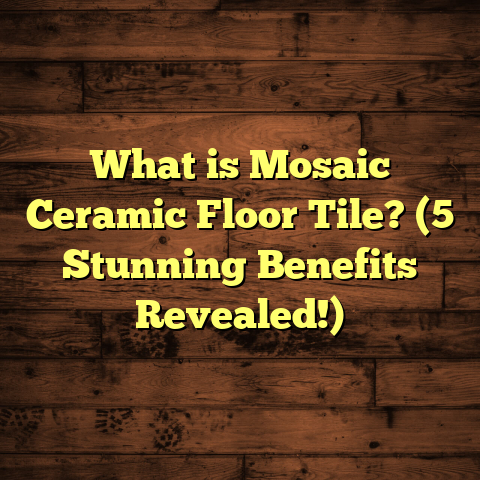What is More Expensive: Wood or Tile Flooring? (5 Key Comparisons)
I remember the time I was helping a close friend pick out flooring for their new home. We spent hours walking through showrooms, flipping over tile samples, and feeling the grain of different wood planks. The biggest question that kept coming up was: “Which one is more expensive—wood or tile flooring?” It wasn’t a simple question to answer because the cost depends on so many factors, from the type of material to installation and ongoing maintenance. I’ve been knee-deep in flooring projects for years, so I thought I’d share everything I know about comparing wood and tile flooring costs — the kind of stuff you don’t always hear in a glossy brochure or showroom.
What is the Real Cost Difference Between Wood and Tile Flooring?
When I say “cost,” I’m not just talking about the price tag on the box or carton. Flooring expenses break down into several important pieces:
- Material costs (the raw product)
- Installation labor costs
- Long-term maintenance and upkeep
- Waste during installation
- Impact on home value and resale potential
Each of these affects your wallet differently depending on whether you go with wood or tile. To give you a clear picture, I’ll explain each piece with stories from my own projects, plus some solid numbers and research results to back things up.
1. Material Costs: The Sticker Price You See Isn’t Always What You Pay
When you first shop for flooring, the material cost usually grabs your attention. It’s the most obvious number you see.
Wood Flooring Material Prices
Wood flooring is often seen as a premium choice because of its natural look and feel. But even within wood, there’s quite a range.
- Solid hardwood typically costs between $5 and $15 per square foot. Species like oak or maple fall on the lower end, while exotic woods like Brazilian cherry or walnut are near the upper end.
- Engineered hardwood can be cheaper, usually $4 to $10 per square foot. It has a real wood veneer over plywood layers, making it more stable in humid environments.
I’ve found that solid hardwood gives a richer look but is more sensitive to moisture changes, while engineered wood is a bit more budget-friendly and practical in certain rooms like basements.
Tile Flooring Material Prices
Tile comes in more varieties than most people realize:
- Ceramic tile is usually the cheapest option — prices start as low as $1 per square foot and go up to about $10 for premium styles.
- Porcelain tile is denser and more durable, averaging $3 to $10 per square foot.
- Natural stone tiles like marble, slate, or travertine can cost anywhere from $7 to over $30 per square foot depending on rarity and finish.
One thing I noticed recently during a client consultation was how many people underestimate the cost of natural stone. It looks stunning but can blow your budget if you don’t plan ahead.
Real-World Data: Comparing Material Costs on a 1,000 Sq Ft Floor
| Material | Average Cost/Sq Ft | Total Cost (1,000 Sq Ft) |
|---|---|---|
| Solid Hardwood | $8 | $8,000 |
| Engineered Hardwood | $6 | $6,000 |
| Ceramic Tile | $4 | $4,000 |
| Porcelain Tile | $7 | $7,000 |
| Natural Stone Tile | $15 | $15,000 |
From this table, you see ceramic tile can be very affordable upfront, but natural stone can easily cost twice as much as hardwood.
2. Installation Labor: The Hidden Expense That Can Surprise You
Material cost is only part of the story. Installation labor often surprises homeowners because it can be equal to or even exceed material costs.
Hardwood Installation Labor
Installing hardwood requires skill and precision. Whether it’s nail-down solid hardwood or glue-down engineered planks, the subfloor needs to be perfectly level and dry. Hardwood also requires acclimation—meaning it has to sit in your home for days before installation to adjust to humidity.
Labor rates for hardwood installation vary by region but generally run between $4 to $8 per square foot. The process is time-consuming; even small mistakes can mean costly fixes later.
In one project I managed, an uneven subfloor led to delays and extra work, pushing labor costs 20% above the estimate. That’s why I always stress preparation and hiring experienced installers.
Tile Installation Labor
Tile installation is equally demanding but different in nature. Setting tile involves laying mortar evenly, precise cutting (especially with intricate patterns), grouting, and sealing afterward.
Tile labor tends to run higher than hardwood on average — about $5 to $10 per square foot. The complexity of tile work can vary widely; large-format tiles are harder to lay flat without lippage (uneven edges), and natural stone requires extra sealing steps.
When installing porcelain tile in a bathroom remodel recently, my crew spent extra time waterproofing and sealing grout lines. This added roughly 15% more labor cost compared to a standard ceramic tile job.
Labor Cost Comparison Table
| Flooring Type | Average Labor Cost/Sq Ft | Total Labor Cost (1,000 Sq Ft) |
|---|---|---|
| Hardwood | $6 | $6,000 |
| Tile | $7.50 | $7,500 |
The difference might not seem huge at first glance, but it adds up on bigger jobs.
3. Durability & Maintenance: What Will You Spend Down the Road?
I always tell clients that initial cost only tells half the story. What about 5 or 10 years later? Let’s talk about upkeep.
Wood Flooring Maintenance
Wood floors need care. They’re vulnerable to scratches from pets or furniture and can suffer water damage if spills aren’t cleaned right away.
Solid hardwood usually needs refinishing every 7-10 years to restore its surface. Refinishing costs range from $3 to $5 per square foot depending on location and floor condition.
Engineered wood requires less frequent refinishing because it has thinner veneer layers; sometimes it’s not refinishable at all.
If you want your wood floor looking great long term, you’ll invest in refinishing plus occasional spot repairs.
Tile Flooring Maintenance
Tile is much tougher against scratches and stains but grout can get dirty or crack over time. Grout maintenance is often overlooked but necessary.
Grout cleaning products and resealing services help keep tile floors looking fresh. Resealing grout typically costs around $0.50 to $2 per square foot every few years.
Tile itself rarely needs replacement unless cracked or chipped severely.
In wet areas like bathrooms or kitchens, tile’s water resistance is a big advantage over wood.
Long-Term Maintenance Cost Comparison (20 Years)
| Flooring Type | Maintenance Activities | Estimated 20-Year Cost |
|---|---|---|
| Solid Hardwood | 2-3 refinishes + repairs | $4,000 – $6,000 |
| Engineered Hardwood | Occasional repairs | $1,000 – $2,000 |
| Tile | Grout cleaning & resealing | $500 – $1,000 |
One client who chose wood ended up spending nearly double on maintenance compared to their neighbor with tile flooring after 15 years.
4. Resale Value & Appeal: What Buyers Want
One question I get asked all the time is: “Which flooring will add more value when I sell my home?”
Wood Floors & Resale Impact
Wood floors have traditionally been seen as a “must-have” by buyers. They bring warmth and elegance that many people prefer over cold tile.
According to the National Association of Realtors (NAR), homes with hardwood floors sold for an average of 2-5% more than comparable homes without them.
I’ve personally seen homes with well-maintained hardwood floors attract higher offers and sell faster in several markets.
Tile Floors & Resale Impact
Tile can add value too — especially in kitchens and bathrooms where water resistance matters most.
However, buyers often view ceramic tile living rooms or bedrooms as less desirable than hardwood unless the tile is high-end or patterned for style.
Natural stone tiles tend to impress buyers but come with higher installation costs that may not always pay off fully on resale.
Real Estate Agent Insight
A local agent once told me: “Hardwood floors are a safe bet if you want broad appeal. Tile works well in specific rooms but isn’t usually a selling point by itself.”
5. Waste & Project Management: How Much Extra Should You Expect?
Waste is often ignored in rough estimates but can impact your budget significantly.
Wood Flooring Waste
When ordering wood flooring, expect about 5-10% waste depending on room shape and layout complexity. Straight runs cut easily with minimal scraps.
I always advise clients to order slightly more than needed — better safe than sorry when boards get damaged or measurements change mid-job.
Tile Flooring Waste
Tile waste is usually higher — around 10-15% — due to breakage during transport or cutting irregular shapes around corners and fixtures.
Intricate tile patterns increase waste even more because you need precise cuts and matching pieces that sometimes don’t fit perfectly without extra material.
On one kitchen project using patterned porcelain tiles, waste reached nearly 18%, which pushed material orders up substantially.
Using Tools Like FloorTally for Accurate Estimates
To avoid surprises with waste and overall costs, I rely on tools like FloorTally that let me input material types, labor rates, and waste factors all at once.
They help me create detailed budgets quickly without juggling multiple spreadsheets or guesswork.
For example, FloorTally automatically calculates waste based on your flooring choice and room layout — which saved me headaches on a large commercial project last year that had complex tile work.
Personal Stories From My Projects: How Costs Played Out in Real Life
I want to share a couple of specific cases from my own work that highlight how these factors interact in real-world settings:
Case Study 1: A Family Room Makeover With Hardwood
A couple came to me wanting warm floors that could handle kids and pets but still look classy. We chose engineered hardwood priced around $7 per square foot with an installation labor rate of about $6 per square foot.
The overall material plus labor came to roughly $13 per square foot installed — totaling about $6,500 for their 500 sq ft space.
Over five years, they refinished once for around $1,500 but otherwise had low maintenance costs thanks to engineered wood’s durability.
They were happy paying slightly more upfront for comfort and style plus resale value boost they expected down the road.
Case Study 2: Kitchen Renovation With Porcelain Tile
Another client wanted durable flooring that could handle spills and heavy foot traffic in their kitchen. Porcelain tile at $8 per square foot was selected along with labor at about $9 per square foot due to complicated pattern work.
Their total installed cost was approximately $17 per square foot — nearly double what a simple ceramic tile job would cost but worth it for durability and aesthetics they wanted.
Grout maintenance over 10 years was minimal — about a few hundred dollars — saving them from refinishing headaches common with wood in kitchens.
How Do You Decide Which Flooring Makes Sense for You?
After reading all this, you might ask yourself: “So which one should I choose?”
Here’s how I help clients figure it out:
- Do you want warmth and timeless appeal? Wood might be worth the higher initial cost.
- Is durability and water resistance top priority? Tile often wins here.
- What’s your budget range? Ceramic tile can be very budget-friendly; natural stone can be pricey.
- How long do you plan to stay? If it’s short-term, lower upfront costs might matter more.
- Are you concerned about resale? Hardwood usually attracts more buyers.
- How do you feel about maintenance? Wood needs refinishing; tile needs grout care.
These questions guide decisions better than just looking at price tags alone.
The Role of Technology in Making Flooring Choices Easier
I want to quickly mention how technology has changed how I plan projects now compared to when I started.
Before tools like FloorTally existed, calculating total costs meant juggling supplier quotes, estimating waste manually, guessing labor hours based on experience — which could lead to errors or surprises later on.
Now I input details about materials (wood species or tile type), room dimensions, labor rates by region, plus waste factors into FloorTally’s platform. It spits out detailed cost estimates instantly so I can show clients realistic budgets before ordering anything.
This helps avoid issues like underestimating how much material we need or forgetting labor complexity for certain installations. It makes budgeting smoother for everyone involved — clients feel confident; contractors avoid costly mistakes.
Final Thoughts Based on Years of Flooring Experience
I’ve installed hundreds of floors over the years — from tiny cabins with rustic pine boards to luxury homes featuring marble tiles imported from Italy. Each project taught me something new about balancing cost with quality and function.
Wood floors offer unmatched warmth and resale appeal but come with higher upfront costs and maintenance needs over time. Tile flooring can be very cost-effective initially (especially ceramic) but sometimes demands more labor investment and grout upkeep later on.
What really matters is matching your flooring choice with your lifestyle needs and budget realities. Don’t just pick based on price alone — think about installation complexity, durability expectations, maintenance willingness, and how long you plan to keep the floor looking great.
If you want help crunching numbers for your project or deciding which option fits best—just ask! I’m happy to walk you through using tools like FloorTally or share tips from my years on the job so your flooring investment feels smart every step of the way.





